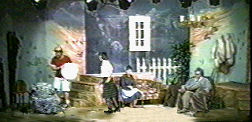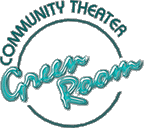|
||||||||||||||||||||||||||||||||||
|
|
Revealing Joe Benjamin for God's FavoriteA built-in bookcase holding a collection of ostentatious, expensive-looking "artifacts" told the background story of factory owner Joe Benjamin in God's Favorite. These items included inexpensive silver, brass, glass, and wood items volunteered by the cast and crew, a "bejewelled" medieval-style cup and a large "primitive" gourd bowl from the TJ Maxx housewares sale table, and my collection of literary classics and antique schoolbooks, among others. The books told the audience that Joe valued learning and scholarship; the African gourd bowl and jeweled cup told us that he could afford to travel and that he had a reverence for the past. The overall impression created by the use of gaudy, shiny objects and diverse textures told the audience that this was a self-made man who was proud of his wealth, but one without the good taste and gentility associated with those "to the manor born." Keeping the Audience Off-Balance in The Skin of Our Teeth
 
Time Stands Still for The ForeignerLarry's Shue's comedy The Foreigner takes place in a comfortable Southern rural lodge, and my job here was to create a sense of the slow-moving South and to tell the audience about the lodge's owner and her circumstances. I did décor only for that show, so I had a lot of time to come up with items. Set designer Paul Janiga gave us a beautiful log cabin interior that was a joy to work with. On two long shelves hung one above the other, I placed stoneware crocks, old-fashioned kitchen implements and mason jars, telling the audience that whoever rules the roost here is probably female, does her own canning, likes to cook, and prefers old-fashioned methods. A bunch of out-of-date magazines and a few Reader's Digest Condensed books suggested that if anybody did any reading around here, they didn't spend a lot of time on it and weren't looking for deep philosophical truths. My antique butter churn took another bow for this show, and reinforced the idea that life here was unhurried and behind the times. A display counter filled with boxes of chewing gum and candy indicated that this was a commercial establishment, not someone's home. A crateful of empty soda bottles stowed neatly under a sideboard suggested that the owner is thrifty and probably not wealthy, since she obviously intends to take her bottles back to reclaim her deposit. A corner filled with fly rods and long wading boots said that fishing is a popular sport in this area, and that the establishment's inhabitants enjoy slow-moving, leisurely activities and getting away from the modern world. A collection of old coats hanging from wooden pegs next to the door suggested that quite a few people are in residence here, and that comfort is more important than style. Finally, a rocking chair and a hooked rug placed in front of a small, authentic pot-bellied stove bespoke leisurely nights spent telling stories in front of a fire. |
|
The
Community Theater Green Room www.communitytheater.org © 1999 - 2007 Chris & Mike Polo All rights reserved. |


 When
your hero, Mr. Antrobus, arrives at the door of his suburban New
Jersey tract home in the middle of the Ice Age, greets the family's
pet dinosaur, and announces that he's just invented the alphabet,
as is the case in Thornton Wilder's masterpiece The Skin of
Our Teeth, it's obvious that the author intends from the get-go
to keep the audience off-balance, particularly regarding time.
To help the set contribute to this imbalance, I opted for a series
of moveable platforms of different heights placed, for the first
act, at 30-degree angles to one another; these were painted to
resemble sandstone. Instead of being stairstepped from lowest
to highest, the tallest platform was place stage right, the lowest
at center, and the medium-sized one on stage left. Characters
moving across the platforms therefore took an odd zigzag up-and-down
movement as they crossed. Since Mr. Antrobus has just announced
the discovery of the wheel and the alphabet, electricity has obviously
not been invented yet; nevertheless, a radio (unplugged, with
the cord left dangling in plain view), graced the stage, and an
electric chandelier hung over Mr. Antobus' easy chair. The walls
that formed the family living room were painted to look like the
Lascaux caves, complete with finger paintings of primitive bison
and horses, fading into a hospital green stenciled with leaves.
The upstage center wall was missing entirely, and a tree growing
outside leaned into the house. The floors were painted to look
like sand, the furniture was reupholstered in animal prints, and
the stage right exit was lined with a variety of fur stoles that
people have donated to the theater over the years (since they
can no longer wear them in public). Finally, the back wall was
painted to esemble a stormy sky; superimposed over it in white
chalk were a couple of large scientific equations and philosphical
quotes, and a large chalk rendering of DaVinci's famous anatomical
man in a circle. Was it a New Jersey tract home, or a nicely-furnished
cave? The beginning of time or Armageddon? For the second act,
the platforms were moved and the flats turned to represent Atlantic
City (or maybe Soddam and Gomorrha). For the third act, we were
back at the cave/tract home, now destroyed by war. Yes, it's a
weird show, and the audience knew that the minute the curtain
opened.
When
your hero, Mr. Antrobus, arrives at the door of his suburban New
Jersey tract home in the middle of the Ice Age, greets the family's
pet dinosaur, and announces that he's just invented the alphabet,
as is the case in Thornton Wilder's masterpiece The Skin of
Our Teeth, it's obvious that the author intends from the get-go
to keep the audience off-balance, particularly regarding time.
To help the set contribute to this imbalance, I opted for a series
of moveable platforms of different heights placed, for the first
act, at 30-degree angles to one another; these were painted to
resemble sandstone. Instead of being stairstepped from lowest
to highest, the tallest platform was place stage right, the lowest
at center, and the medium-sized one on stage left. Characters
moving across the platforms therefore took an odd zigzag up-and-down
movement as they crossed. Since Mr. Antrobus has just announced
the discovery of the wheel and the alphabet, electricity has obviously
not been invented yet; nevertheless, a radio (unplugged, with
the cord left dangling in plain view), graced the stage, and an
electric chandelier hung over Mr. Antobus' easy chair. The walls
that formed the family living room were painted to look like the
Lascaux caves, complete with finger paintings of primitive bison
and horses, fading into a hospital green stenciled with leaves.
The upstage center wall was missing entirely, and a tree growing
outside leaned into the house. The floors were painted to look
like sand, the furniture was reupholstered in animal prints, and
the stage right exit was lined with a variety of fur stoles that
people have donated to the theater over the years (since they
can no longer wear them in public). Finally, the back wall was
painted to esemble a stormy sky; superimposed over it in white
chalk were a couple of large scientific equations and philosphical
quotes, and a large chalk rendering of DaVinci's famous anatomical
man in a circle. Was it a New Jersey tract home, or a nicely-furnished
cave? The beginning of time or Armageddon? For the second act,
the platforms were moved and the flats turned to represent Atlantic
City (or maybe Soddam and Gomorrha). For the third act, we were
back at the cave/tract home, now destroyed by war. Yes, it's a
weird show, and the audience knew that the minute the curtain
opened.